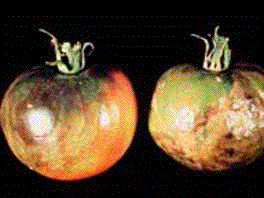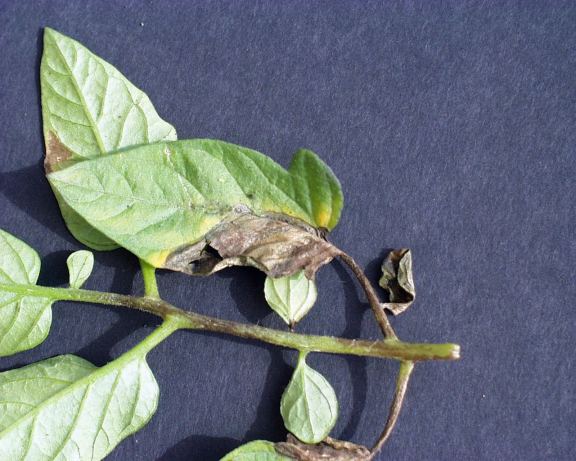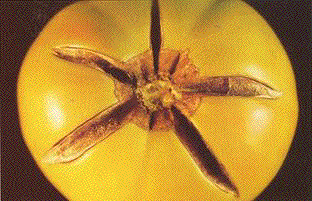
Tomatoes - and tomato plant problems - abound this time of year. Good sources of information to help you solve your tomato travails are the books, "Western Garden Problem Solver" from Sunset; plus, two books from the University of California Press, "Pests of the Garden and Small Farm" by Mary Louise Flint and "The California Master Gardener Handbook," edited by Dennis Pittenger. All three books take an integrated pest managament approach to solving plant woes. Instead of first reaching for harsh chemical controls, the books suggest adopting cultural, physical, mechanical and less toxic methods to solve the problems. Some of these solutions border on common sense, such as not planting tomatoes in too much shade; ripping out and destroying problem plants; or, trapping snails at night beneath boards, then destroying them the following morning.
Here are a few of the tomato problems you've been asking about this year, along with possible solutions, that can be found in greater detail in those publications.
Symptoms: Tomato leaves eaten, areas of fruit eaten, black, pellet-like droppings on and below plant. Possible culprit: Tomato hornworm. Solution: Hand pick in evening or morning. Use sprays that contain Bacillus thuringiensis, a less toxic microbial pesticide, to control young hornworms.
Symptoms: Tomatoes are brown or black on the bottom end. Possible culprit: Blossom end rot. Due to a calcium imbalance, brought on by cycles of too much or too little water. Solution: Maintain even soil moisture. Avoid varieties most prone to it.
Symptoms: Poor vigor, reduced yields, tomato leaves turn brown from the bottom up. Swellings on the roots. Possible culprit: Root knot nematodes. Solution: Plant resistant varieties, labeled "VFN". Rotate crops. Solarize soil. Add compost.
Symptoms: Tomato fruit turns light brown and leathery, on side exposed to sun. Possible culprit: Sun scald (sunburn). Solution: Don't prune leaf cover from plant. Keep plant vigorously growing to produce more leaves.
Symptoms: Tomato fruit with deep ridges, radiating from stem. Possible culprit: Fruit cracks, which occurs during hot, sunny days. Solution: Keep soil evenly moist and maintain leaf cover.
Symptoms: Tomato plants grow slowly and wilt. Roots have water-soaked areas that turn brown and dry up. Possible culprit: Phytophthora root rot, common in overwatered clay soils. Solution: Avoid heavy watering for long periods. Water more frequently for shorter periods.
Symptoms: Tomato plants turn yellow on one side, spreads to rest of plant. Inside of main stem at base is dark red instead of ivory color. Possible culprit: Fusarium wilt. Solution: Plant resistant varieties, labeled "VFN". Rotate crops. Solarize soil. Remove old plants.
Symptoms: Older tomato leaves yellow, beginning between main veins. Internal stem is slightly tan colored, in small patches. Possible culprit: Verticillium wilt. Solution: Plant resistant varieties, labeled "VFN". Rotate crops. Solarize soil. Remove old plants.
RAIN RELATED TOMATO PROBLEMS

BACTERIAL SPECK: Hits during rain or overhead irrigation early in the season, during cool weather. Retards growth, reduces yields up to 25%, fruit spots, leaf spots. Leaf spots are near the edge of the leaf, dark brown with a yellow ring. Can spread throughout the leaf margin area. Common in cool coastal areas of CA. Solution: plant later in the season; avoid overhead watering.
====

BLACKMOLD: More common in the late season, when rain or free water affects ripening fruit. Can be cosmetic, or cause deep lesions. Pick fruit as it ripens; keep fruit surrounded by leaf canopy.
=====


LATE BLIGHT: Develops during spring rain or overhead irrigation when air temperatures are near 70. The fungus overwinters on nearby areas where potatoes or tomatoes may have been planted. Purple-brown areas on leaves, turn to brown. Fruit may brown, but stays firm. Avoid sprinkler irrigation in cooler weather, especially if potatoes are nearby. Do not use sprinklers on bush-type tomatoes that have developed a dense canopy. Clean up and discard crops after harvest.
===================

TOMATO FRUIT CRACKING. Radial cracking occurs during rainy periods, when rains follow long dry periods. Fruit exposed to the sun may also develop cracks. Maintain a uniform water supply through the use of irrigation or mulches. A full leaf canopy will also help protect fruit from the sun and reduce cracking.
====================
Other problems that may be attacking your tomatoes this summer include whiteflies (control with insecticidal soap), aphids (ditto), late blight (avoid sprinkler irrigation), powdery mildew (give plants full sun, regular watering and avoid excess fertilizer), tomato russet mites (don't plant tomatoes near petunias or potatoes) as well as cosmetic tomato problems such as cat facing (puckering of fruit caused by cool weather when plant bloomed) and concentric circles near the stem (due to sudden, rapid growth).